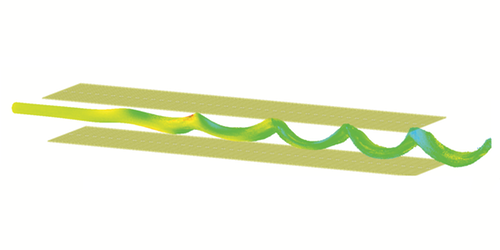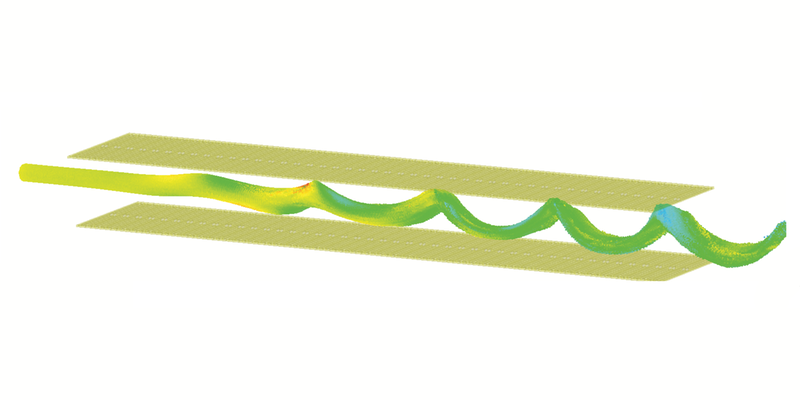Better Microwaves from a Metamaterial
Sources of high-power microwaves—required by radar systems and telecommunications transmitters, for example—generally use a beam of electrons to amplify waves traveling in a metal waveguide structure. Researchers have now demonstrated an exotic twist to this method by using a so-called metamaterial waveguide: an electron beam generates waves, but going in the direction opposite to the beam. The technique could help to improve the power and efficiency of microwave sources.
A metamaterial is a composite structure that has electromagnetic properties not normally found in nature. For example, while natural materials all have a positive index of refraction—the parameter that determines how light bends as it enters the material—a metamaterial can have a negative index, so that light entering bends in an unusual way. Metamaterials can make seemingly impossible electromagnetic effects possible, including cloaks that make objects partially invisible.
Theorists have speculated that metamaterials might also be used to improve microwave generation, by altering the electromagnetic properties of a standard waveguide, which is a rectangular “pipe” through which microwaves propagate. A waveguide adorned with the right metamaterial components could have both a reduced speed for electromagnetic waves and a negative index of refraction. Electrons moving through this structure faster than the wave speed could generate intense microwave radiation traveling backwards, against the electron beam. Such “reverse Cherenkov radiation” would be analogous to ordinary Cherenkov radiation, which is created when charged particles move faster than the speed of light in a medium where light travels more slowly than in vacuum.
Seeking to test this idea, Richard Temkin and his colleagues at MIT built a waveguide, roughly 3 4 cm in cross-section, in which the usually smooth top and bottom surfaces were replaced by copper sheets containing a repeating pattern of curved slots shaped like elongated Cs. The team then sent a pulsed beam of 500-keV electrons through the waveguide. To prevent the beam from exploding apart because of the mutual repulsion of the electrons, the researchers applied a strong magnetic field along the beam direction.
As expected, the team detected intense microwaves generated in the reverse direction. However, they also found a surprise—the waves weren’t produced through the reverse Cherenkov scenario, in which electrons move in a straight line. Further examination showed instead that the electrons were moving along helical paths curling around magnetic field lines. Changing the strength of the field altered the nature of the microwaves produced, as it changed the electrons’ helical motion. The waves that were generated came about through a different mechanism, known as the Cherenkov-cyclotron instability, says graduate student team member Jason Hummelt.
“We were successful in our goal of generating coherent radiation,” says Hummelt, “but the mechanism was different, which was very surprising. The electron beam has a much more complicated orbital motion than in the reverse Cherenkov scenario.”
This study, he says, adds to physicists’ understanding of the complex interactions possible between charged particles and waves in metamaterial structures and may soon lead to better ways to generate high-power microwaves. Hummelt says that, compared with current microwave generation systems, the charged particles appear to give their energy to microwaves more efficiently through the Cherenkov-cyclotron mechanism, so this technique could lead to a more efficient microwave generator.
“This work opens up the possibility of exploring the huge parameter space for beam-wave interactions,” says Edl Schamiloglu, an electrical engineering professor at the University of New Mexico in Albuquerque. “This might lead to brand new concepts for high-power oscillators and amplifiers with performance beyond what can presently be achieved.”
This research is published in Physical Review Letters.
–Mark Buchanan
Mark Buchanan is a freelance science writer who splits his time between Abergavenny, UK, and Notre Dame de Courson, France.





